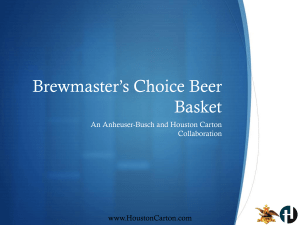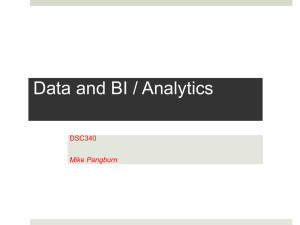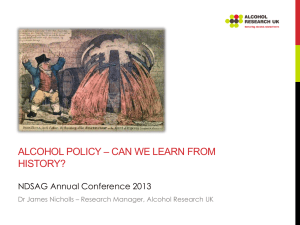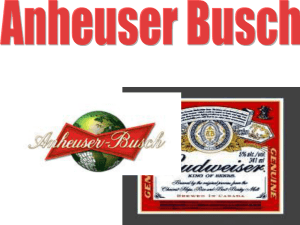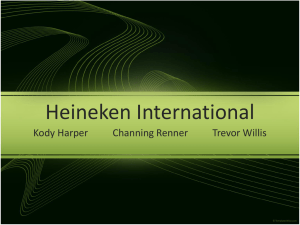Lion Nathan Limited
advertisement
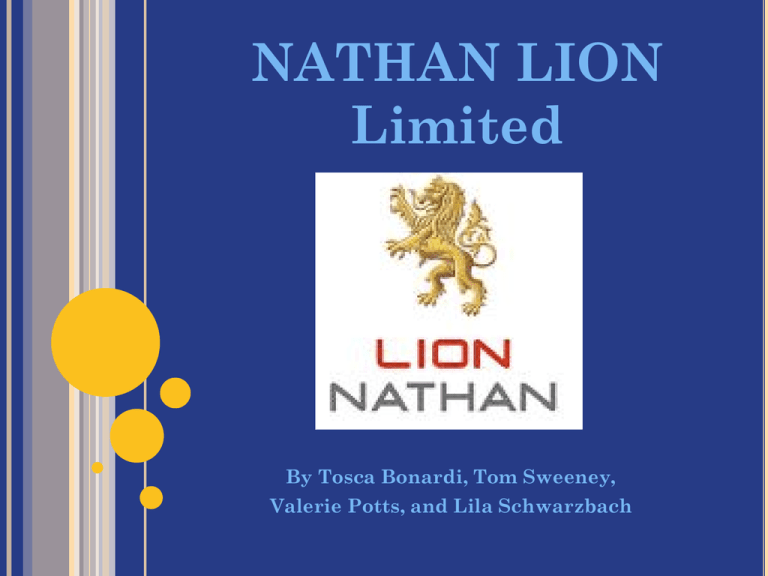
NATHAN LION Limited By Tosca Bonardi, Tom Sweeney, Valerie Potts, and Lila Schwarzbach NATHAN LION LTD THE BEGINNING The Formation 1988 Lion Corporation and L.D. Nathan and Co. merge Hire and outside guy in 1999 Kevin Roberts International experience Australian and New Zealand markets Hinder further growth potential several evaluations on different breweries in China LN entered China’s market two years later in April 1995 with a 60% joint venture Wuxi. The first investment was made in Yangtze River Delta, China’s fastest growing beer market. NATHAN LION THE BEGINNING Increasing ownership 1996: increase to 80% with plans to build a new $378 million brewery. Licensing agreement After the construction of their new brewery German brewer Brauerei Beck and Co. to brew the premium beer, Beck’s. Kirin Brewery Company In 1998, KBC acquired a 45% share of LN ownership structure changed significantly By the end of 1998 LN’s growth potential was still very promising. CHINESE BEER INDUSTRY Beer is a beverage Variety of flavors, colors and types. Different tastes, price range, and quality. Technology Slow paced changes Routine and automated process Popularity- Attractive to international brewers China’s population Immense growth potential In 1998, 600 brewers produced 17.8 tonnes of beer GROWTH Capacity of breweries in China in 1998 Market Growth 80 hold over 50 million liters Of those 80, 18 breweries could hold over 100 million liters. The 10 largest companies only held less than 20% of the market. Through the 80’s: growing at a rate of 20% a year. Between 1992 and 1997: rate of 12.5%. 1998and 2001: Projected to continue dropping to 6%. Comparisons by liter per capita New Zealand - 87 liters Australian - 95 liters Asian market as a whole - 30-40 liters MARKET SEGMENTS AND DEMAND China’s beer industry has four segments Imported premium Premium Mainstream Low-end Demand fluctuates Levels of unemployment Disposable income Government rulings Beer consumption Analyzed by regions – many little markets Urban and rural areas RAW MATERIALS, CAPITAL REQUIREMENTS AND ENTRY/EXIT EASE Hops Capital Requirements: Small Companies Not high for small businesses Building breweries is costly Developing brand identity Capital Requirements: Big Companies Companies buy raw materials Easier for companies Brewing plants in every region Economies of scale Extensive marketing Exit Hard for small businesses – no market CHINESE ECONOMY Entering Chinese Market Downward trend Advanced market World’s largest consumer market China’s market looked very promising Size of market Growth potential Low barriers to entry No established “big guy” China’s consumer market Exponentially growing consumer market OTHER COUNTRIES Presence in New Zealand and Australia Lacked growth potential Dominated by supply and demand Differences between economies Growth potential Population Economic growth Growth rate Promising market NEGATIVES ASPECTS OF ENTERING CHINA Low GDP per capita Australia and New Zealand’s higher GDP per capita Infrastructure in China Well developed on coast Weak inland transportation No public transportation system Few private auto owners Infrastructure in Australia and New Zealand Well developed nationally BEER MARKET Chinese Economy in downward spiral Competition in beer market intensifying Premium beer market Consumers buying habits Willing to try new brands (low brand loyalty) Daily “Mom and Pop” visits Culture Beer is a social beverage, like tea or soda Accompanies a meal Enjoyed warm BEER MARKET Consumption Habits Lower in China than others LN must pay close attention to distribution Marketing Customers under 30 are more responsive to advertising YANGTZE RIVER DELTA Five Regions Shanghai Suzhou Wuxi Nanjing Changzhou COMPETITORS HUMAN RESOURCES AND CORPORATE CULTURE No problems finding qualified employees Previous retail experience Under 30 2 years experience with MNC Individual performance targets Bonuses negotiated. Status, reputation, reliability, and loyalty influence position, promotion, relationships. Personal goals, Retention of staff Employee training systems T CHINA’S CULTURE High-context culture emphasizes social relationships between individuals Trustworthiness is a key trait in business dealings. Employee loyalty, building corporate expertise is vital. Chinese dislike individual pressure. Occasionally LNC head office managers apply more pressure than most Chinese workers are accustomed to in order to meet financial targets. T MARKETING STRATEGY Lion Nathan regularly: Measures the health of their brand Examines the effectiveness of their advertising Uses past experiences for positioning and promotion Positioning in each market: River Delta and Shanghai – locality = comfort, affiliation. High-quality premium beers are marketed differently price, bottle design, position, label, and placement. Ex: Beck’s and Steinlager Affordable and acceptable pricing Event sponsorships. T MARKETING FOR THE FUTURE 15% market share in River Delta region, 8% in Shanghai, 25% in Suzhou, 40% in Wuxi, 16% in Nanjing. Distribution is an issue Sales are directly related to their distribution coverage Focus on expanding in River Delta region and Shanghai. Build for the future. Already have superior brand recognition Create more effective distribution channels T



